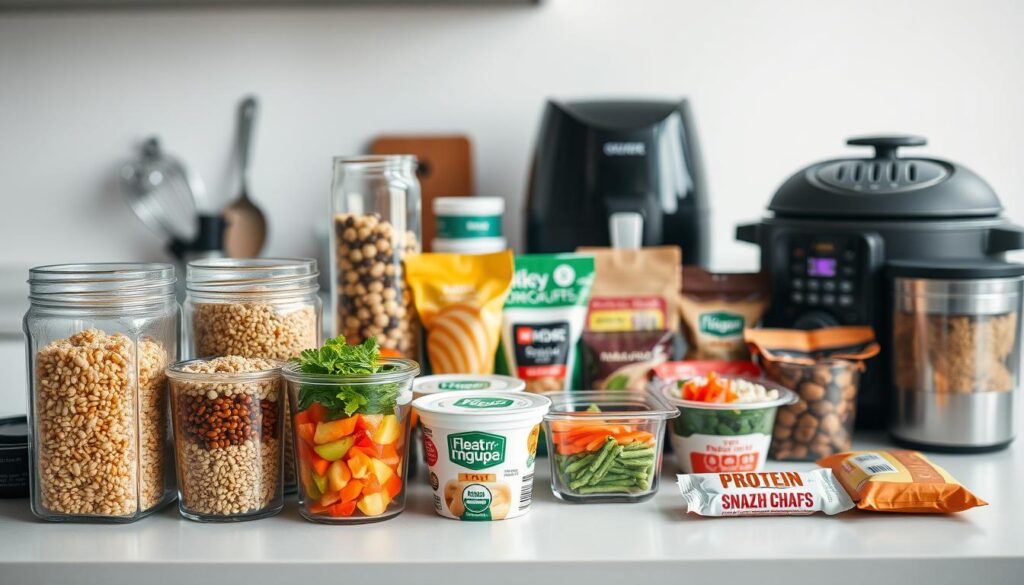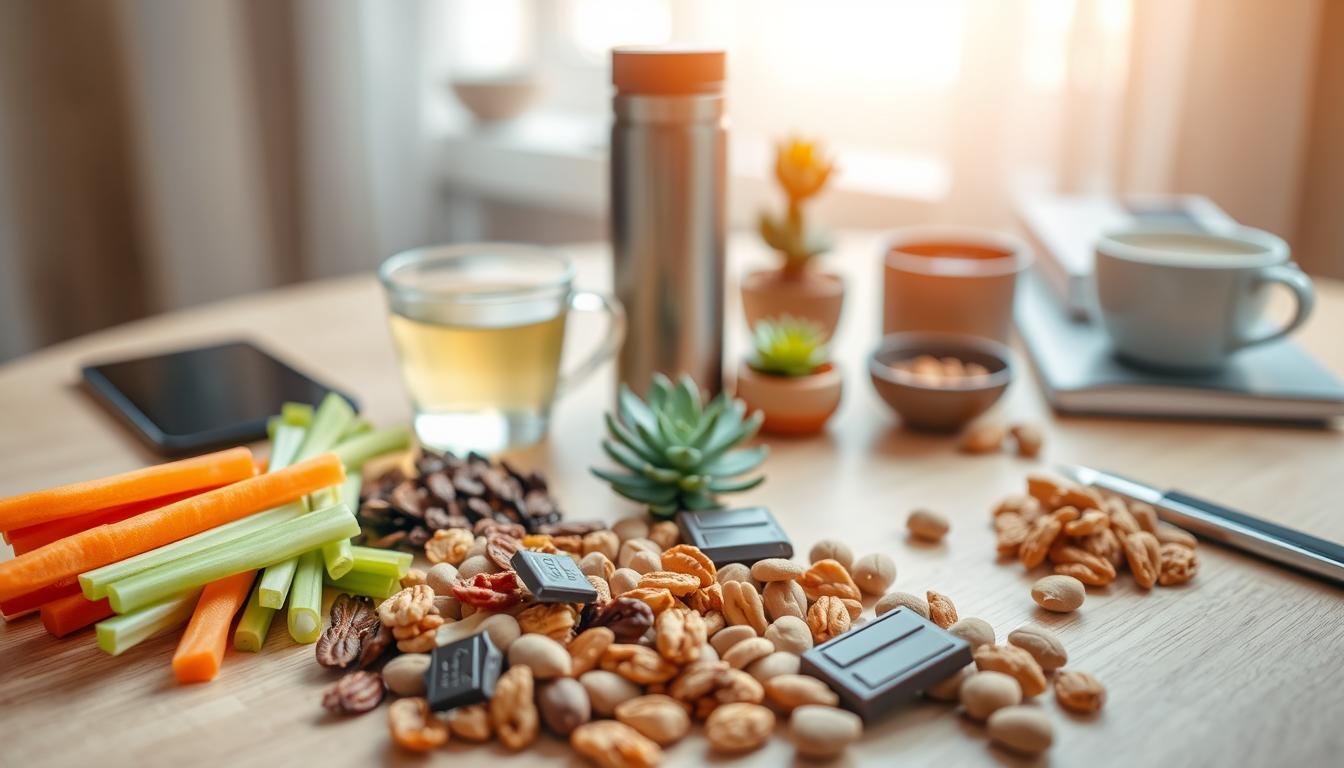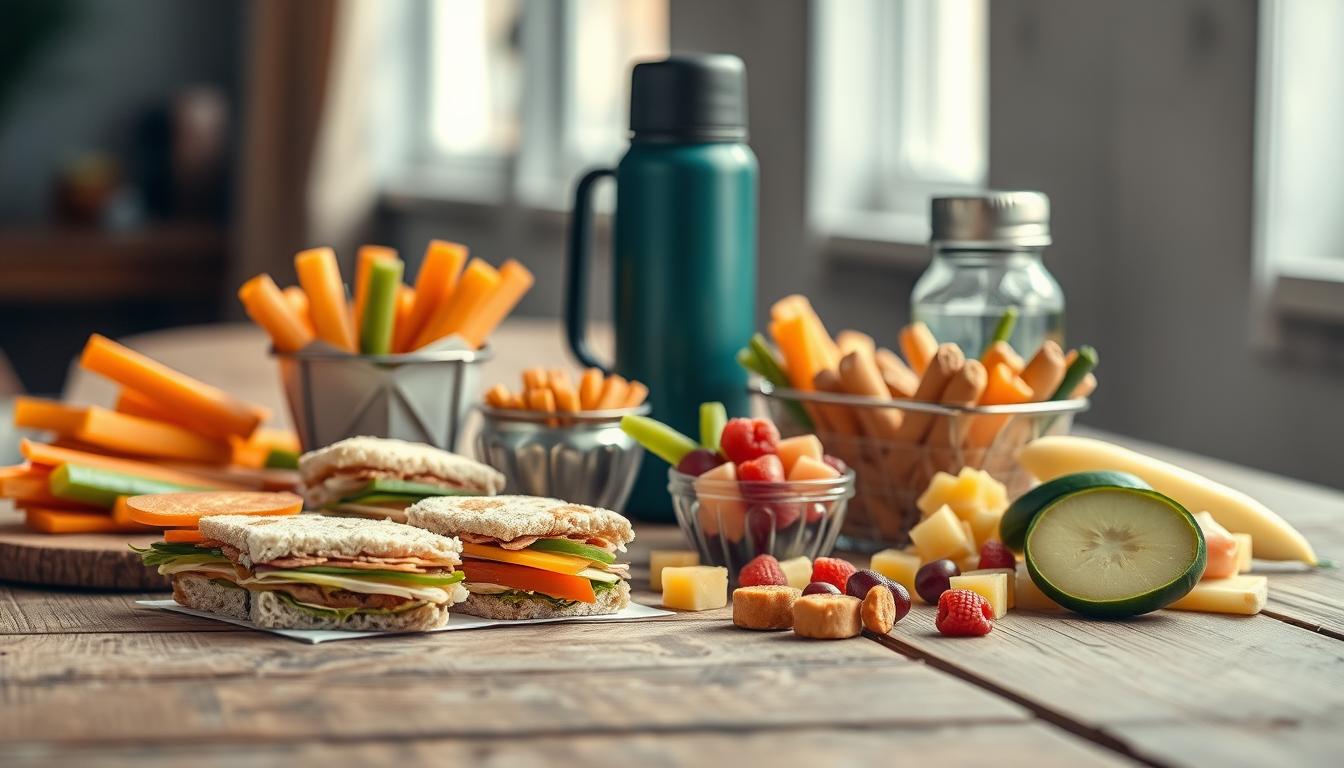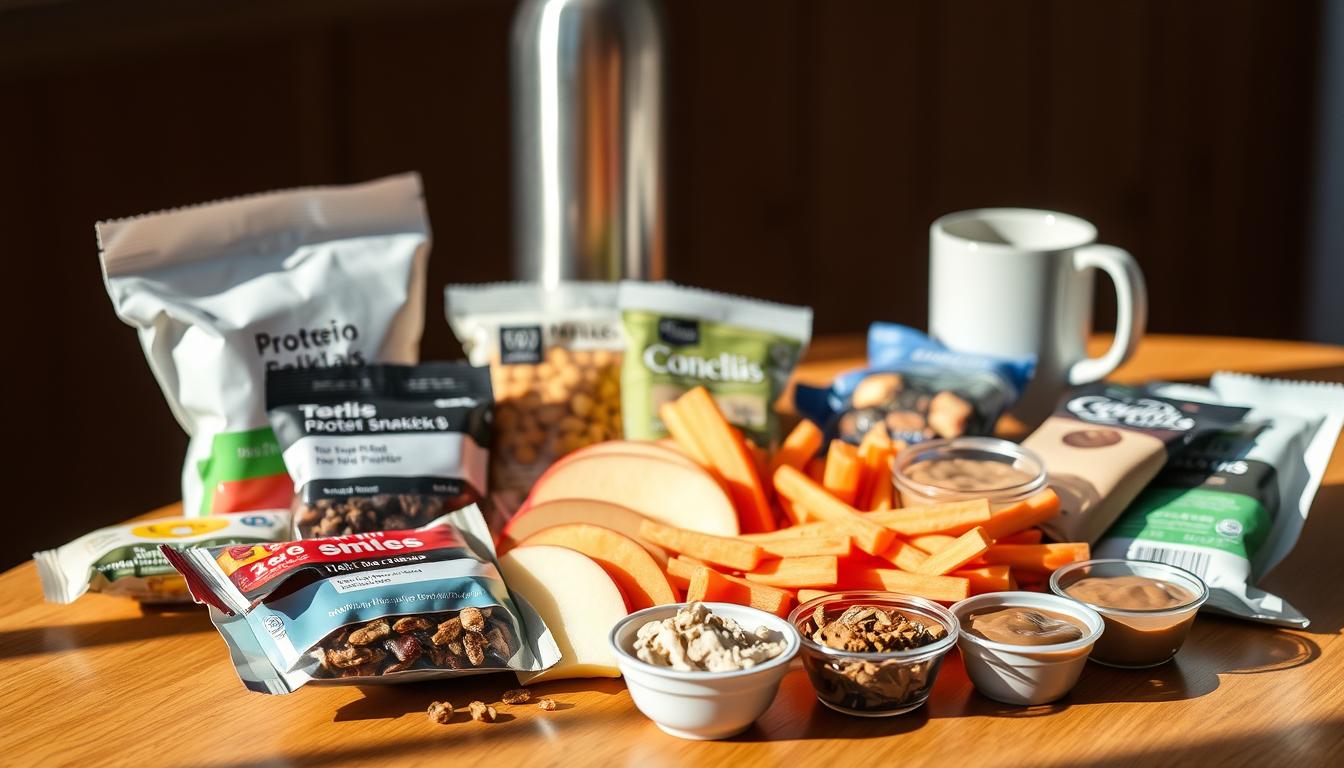Starting meal prep with one hand may seem hard. It’s especially true for those making work lunches. Yet, with a focus on efficiency, single-handed cooking becomes possible without skipping on good nutrition. This guide shares smart meal prep tips for work. It shows ways to make meal prep easy and productive.
For example, organizing the kitchen with specific spots for different tasks helps reduce unnecessary moves and boosts efficiency. Tools like rocker knives and special utensils make cooking easier and more fun. And using ready-to-go ingredients cuts down on prep time. This lets you concentrate on cooking safely, using options like microwaves or stovetops.
With the right equipment and methods, anyone can get good at single-handed meal prep. This way, you can have tasty and healthy meals all week long.
Introduction to Meal Prep
Meal prep means preparing meals ahead of time. It helps people eat healthy home-cooked meals all week. It’s perfect for busy folks who want to eat well despite tight schedules. Knowing the basics of meal prep helps you cook less and eat better.
Preparing meals before you need them saves time. You can make meals in advance to have something quick to eat on busy days. Start by using dinner leftovers for lunch the next day. Soon, you can plan and prepare meals for the entire week.
Choosing durable foods is key for meal prep success. Go for foods like cooked grains, pasta, beans, roasted veggies, and lean meats. Avoid soft fruits and crunchy fried snacks, as they don’t last long. Pick foods that stay fresh for 3 to 7 days to cut down on waste.
Good storage containers are important. Use blue-top Ziploc, glass Pyrex, or metal bento boxes. They are airtight and safe for the freezer. Planning and organization are important for meal prep. Making a shopping list, sticking to a cooking schedule, and picking recipes in advance help a lot.
Understanding the Benefits of Meal Prep
Meal prep has many benefits that can change how we cook and eat. It’s becoming more popular as people look for efficient ways to feed themselves. Meal prep helps save time and encourages eating better.
Time-saving Advantages
Meal prep can save you a lot of time during the week. By cooking meals ahead, you have more time for other things. Here are some tips for saving time:
- Batch cooking proteins, such as chicken, fish, or tofu, makes putting meals together easier.
- Cutting up veggies and preparing snacks ahead of time can speed up meal times.
- Cooking basic foods like grains and legumes in advance helps put meals together quickly.
- Freezing meals means you always have healthy options ready, without needing to cook every day.
Healthier Eating Choices
Meal prep leads to healthier eating. Planning your meals makes you more likely to use whole, nutritious foods. It helps you avoid junk food. Here’s how meal prep makes eating better easier:
- Portion control is simpler, which can help with weight management.
- Having ready-to-eat healthy meals ensures your diet is balanced.
- Cooking at home means eating less fast food, which is healthier.
- Adding plant-based foods to your meals increases your nutrient intake.
Tools and Equipment for One-Handed Cooking
Choosing the right tools for one-handed cooking is crucial. It’s about finding kitchen aids and appliances that make cooking safer and easier. This way, people can prepare meals efficiently, without much hassle.
Adaptive Kitchen Tools
There are many kitchen tools designed for those with limited hand mobility. They include:
- Adaptive Cutting and Paring Board: Features spikes to hold food in place, making cutting safer and easier, complemented by an L-shaped corner guard for spreading condiments.
- Rocker Knife: This innovative knife allows for cutting with a rocking motion and comes in vertical or horizontal handles for added convenience.
- One-Handed Can Opener: A battery-operated option that opens cans smoothly without sharp edges, ensuring safety.
- Clamp-On Vegetable Peeler: Secures to the counter, making peeling straightforward with just one hand.
- Non-slip Matting: Keeps bowls and cutting boards in place during use, which is crucial for a stable cooking environment.
Essential Appliances for Efficiency
Efficient appliances make one-handed cooking better. They help speed up cooking tasks. Here are some key ones:
- Adaptive Kitchen Workstation: Combines cutting, grating, and jar-holding features, allowing for versatile meal preparation in a compact unit.
- OXO Smooth Edge Can Opener: This tool locks securely in place, permitting one-handed operation without the need for gripping tightly.
- Chef’s Knife and Kitchen Shears: Essential tools that are designed for one-handed use, promoting effective and creative culinary tasks.
- Folding Pan Holder: Aids in holding pans on the stove while stirring, ensuring that the cook can manage everything comfortably.
Creating a Meal Prep Plan
Meal prep planning starts with picking recipes for the week. This makes sorting meals and ingredients easier. First, choose recipes that share some common ingredients. This reduces waste and uses what you have wisely. Try to include protein, fat, fiber, and greens in each meal. This mix ensures each dish is healthy and suits different tastes.
Making a grocery list is next. Write down all the items needed, from proteins to veggies. Quick options like rotisserie chicken or marinated beans can make meals tastier with little work. Also, consider using a CSA to get fresh produce and help local farmers. This makes your meals fresher and more diverse.
Plan your cooking tasks to save time. For example, cook proteins and veggies together on a sheet pan at 425°F for about 40-50 minutes. This method is quick and saves resources. Salmon will be ready in 10-15 minutes, while chicken needs 20-25 minutes at 400°F. Hard veggies like broccoli and Brussels sprouts cook in 40-50 minutes. But, softer ones like asparagus only need 20-30 minutes. Line pans with parchment for an easy clean-up. Store greens in a salad spinner to keep them crisp for longer.
This meal plan is great for different lifestyles. It allows flexibility for breakfast, lunch, or dinner. By planning well and making a detailed grocery list, the whole meal prep becomes easier.
Single-handed Meal Prep for Work
Creating easy work meals starts with great single-handed meal prep strategies. Choose simple recipes and pack them easily for nutritious options. Picking the right ingredients is key to quick assembly and a healthier life.
Strategizing Your Recipes
Thoughtfully pick your recipes for meal prep. Include ingredients that are:
- Simple to handle and need little prep work
- Good for bulk cooking to make different meals
- Freezer-friendly, like taquitos or pancakes, to last three months
Try planning your meals around dinners to cut down on daily cooking. Cook proteins in large quantities and season them differently to keep things interesting. Keep pre-cut veggies and cooked grains ready for quick meal assembly.
Choosing the Right Ingredients
Finding the right ingredients is essential for easy, tasty, and healthy work meals. Focus on:
- Quick-cooking proteins like chicken or lentils
- Grains you can make in large amounts, such as rice or quinoa
- Veggies that go with everything
Meal prep tools such as glass bowls and portioned containers help with packing and organizing. Use freezer-safe containers for storing extra meals. Cooking in components allows for mixing and matching, keeping meals fun and satisfying.
Organizing Your Cooking Space
A tidy cooking space boosts efficiency, especially when you’re cooking with one hand. Setting up your kitchen with everything close by makes meal prep smoother. It’s key to divide your kitchen into different zones for safety, less walking around, and better focus.
Setting Up Efficient Stations
To organize your kitchen for one-handed cooking, create specific areas. Think about important spots for:
- Preparation: Place big spoons, measuring tools, knives, and must-have machines like KitchenAid and blenders close to you.
- Cooking: Have pots, pans, and gadgets like the Instant Pot ready for quick use.
- Serving: Set aside spots for plates, bowls, and utensils to serve meals easily.
- Eating: Keep your daily use dishes and glasses in a special area.
- Storing: Put plastic containers and boxes where you can grab them without hassle.
Using the EEEEZ method—excavate, evaluate, edit, and establish zones—you can make sure every area has what you need. Thinking about how much you use things helps you choose what stays or goes, keeping your kitchen both useful and nice to look at.
Environmental Modifications for Safety
Being safe in the kitchen is super important. Add a few safety steps to your cooking space:
- Keep a trash bowl or bin nearby to cut down movement and keep things clean.
- Set up “stations” for different jobs, bringing together tools and ingredients to avoid spills and mishaps.
- Stop cutting boards from sliding with wet towels underneath them.
- Plan your kitchen tasks to move in one direction, like left to right, to stop food from getting mixed up.
- Clean surfaces with wet towels as you work, keeping your space tidy and welcoming.
Cleaning and organizing your kitchen items regularly makes cooking easier and safer. A few simple tweaks can improve your cooking experience, making time in the kitchen more fun.
Food Preparation Techniques
Learning different food prep methods can make cooking way easier. Knowing how to chop and prepare in advance makes healthy eating simpler. By chopping veggies ahead and cooking meals for the week, you save both time and energy.
Chopping and Prepping
Being good at chopping can really help with meal planning. If you chop lots of fruits and veggies at once, you won’t have to do it over and over. Using special cutting boards or knives can make chopping easier and safer. Here are some tips for better chopping and preparing:
- Gather all ingredients before starting to maintain focus.
- Use a scrub brush attached to the sink for one-handed vegetable washing.
- Practice egg cracking techniques for one-handed use.
- Store chopped ingredients in clear containers for easy access.
Batch Cooking and Batching Recipes
Batch cooking lets you make several meals at once, perfect for busy days. Cook grains in big batches to use in different dishes, and freeze portions of stews for later. Here’s how to get started with batch cooking:
- Plan meals for the week, focusing on dishes that can be repurposed for multiple meals.
- Write a grocery list and stick to it to avoid impulse buys.
- Prepare snacks like nuts and fruits in advance for healthier choices.
- Schedule dedicated time for meal prepping, such as a few hours one or two days a week.
Utilizing Convenience Foods
Convenience foods offer a quick way to make meals simpler. They come in many varieties to save time but still let you eat well. Adding them to meal prep can change how you cook, allowing for fast, healthy dishes easily.
Pre-Prepped and Frozen Options
Pre-prepped ingredients make meal prep quicker. Consider using:
- Precooked sausage, meats, or meatballs are great for quick meals, like salads or pasta.
- Frozen veggies and fruits are handy for stir-fries or side dishes.
- Hard-boiled eggs are a good, protein-packed snack or addition to meals.
- Pre-portioned hummus, guacamole cups, and nut butter bring healthy fats and flavor to your food.
These options simplify meal prep, freeing up time for other things while ensuring you eat well.
Making Use of Instant Meals
Instant meals have become a favorite for fast, nutritious eating. Add protein powder to shakes or meals for a nutrition boost. It’s important to choose healthier options even among convenience foods, to eat better. This way, you eat consciously.
Plan meals, including snacks and dinners, to watch what you eat. A well-stocked pantry and a good shopping list help keep healthy, easy foods ready.

Maximizing Efficiency in the Kitchen
Making your kitchen more efficient can make cooking much better. Use smart tips to make your cooking smoother. Start by planning meals with the same ingredients. This cuts down on the items you need and saves time. Choose a food theme for each week, like “Meatless Monday” or “Stir-Fry Friday.” This makes planning meals simpler and helps you decide what to cook.
Organizing your shopping can also make your kitchen work better. Try using grocery pickup services to save time and avoid buying things you don’t need. For a fast breakfast, try overnight oats. They save cooking time and give you healthy options ready to go.
Setting up your fridge for meal prep can really help. Prepare and organize ingredients ahead of time for easy meal assembly during the week. Use any extra fruits and veggies for snacks. This reduces waste and keeps healthy snacks ready. Plan your meals by thinking about your energy levels. Match simpler meals with busier days.
Cooking versatile main ingredients can help through the week. Use different seasonings on these basics to keep meals interesting without extra work. Set aside a day like Sunday to get ready for the week. Keep everything in clear, sealed containers for freshness and easy access.
- Designate “Leftover Nights” to creatively repurpose cooked ingredients into new meals, effectively reducing both waste and time.
Cleaning and Maintenance While Cooking
Keeping your kitchen clean while cooking is key to an easy meal prep. Follow effective cleaning tips to turn a chaotic kitchen into a neat space. Use a dishwasher when you can to cut down on washing up time. For pots and pans that need hand-washing, soak them in hot, soapy water right after use. This makes them easier to clean.
To dry dishes, lay a tea towel on a counter and wrap it around each one. This prevents water marks and keeps things tidy. The Adaptive Cutting and Paring Board, made from easy-to-clean high-density polyethylene, helps keep cleanliness. Use a dishwasher-safe chopper to make cleaning up a breeze.
Having a garbage bowl nearby for scraps and trash can save you many trips to the bin. Keep a wet cloth or sponge close for wiping up spills quickly. Cleaning up during short breaks, like when food is simmering, helps keep the kitchen clean.
Tools like a non-slip matting from Dycem can keep bowls steady, making less mess. The Adaptive Jar Opener can also reduce spills when opening jars. Using these tips will help make cooking and cleaning simpler and more efficient.
Tips for Stress-Free Meal Prep
Stress-free cooking needs you to be calm and use smart tactics. Bringing mindfulness into meal prep helps reduce stress. This lets you enjoy cooking more and not feel swamped. Taking your cooking slowly can greatly improve your experience.
Mindfulness and Rushing
Rushing while preparing meals often causes errors and stress. Focus on these key tips for a calmer cooking time:
- Create a meal plan that’s easy to change. Focus on prepping ingredients instead of cooking everything ahead.
- Spend 1-2 hours each week on planning and preparing. This way, handling your cooking tasks becomes simpler.
- Check your fridge and pantry often. This helps you know what you have, reduces waste, and makes meals better.
Including Help from Friends or Family
Cooking becomes more fun when you do it with others. Having friends or family help can make meal prep enjoyable:
- Split the work by preparing ingredients or cooking in big batches together. This saves time and helps everyone bond.
- Have a plan for when you’re very busy. Ready-to-eat frozen meals or simple recipes can lessen stress on hectic days.
- Try doing meal prep as a group activity. Everyone brings something to the table, making the process easier and more varied.
Conclusion
Efficient meal prep strategies can make cooking a breeze, especially if you’re cooking by yourself. To make things easier, plan your meals ahead. Use tools that help you cook with one hand and prepare some ingredients early. This way, you save time and eat healthier. For example, cut veggies like carrots and bell peppers beforehand. Cook grains and legumes early too, so they’re ready when you’re busy.
Getting your kitchen set up right is key. Organize your cooking space well. Batch cooking and using ready-to-eat foods can make your routine easier. Tools like a one-handed cutting board or an electric can opener can boost your single-handed cooking. These tips make cooking more fun and less of a hassle.
The real secret to meal prep success is finding what works best for you. Make sure to keep your meals fresh and quick to make. Putting together dishes like casseroles or making your own salad dressings can make a big difference. By following these tips, meal prep becomes a fulfilling activity. It prepares you for a successful week ahead.



